AMD Radeon HD 7750 & Radeon HD 7770 GHz Edition Review: Evading The Price/Performance Curve
by Ryan Smith & Ganesh T S on February 15, 2012 12:01 AM EST- Posted in
- GPUs
- AMD
- HTPC
- GCN
- Radeon HD 7000
Power, Temperature, & Noise
As always, we wrap up our look at a new video card with a look at the physical performance attributes: power consumption, temperatures, and noise.
While it’s the second sub-series of the 7000 series, the 7700 series is actually first in a number of ways for AMD. It’s the first midrange series to feature PowerTune since its introduction in 2010, and it’s the first time the 28nm process has been used on such low power cards. As such the power, temperature, and noise characteristics of the 7700 series are virtually a blank slate waiting to be filled.
| Radeon HD 7700 Series Voltages | ||||
| Ref 7750 Load | Ref 7770 Load | XFX R7770 BESDD | ||
| 1.1v | 1.2v | 1.2v | ||
The idle voltage for all 3 of our 7700 series cards was 0.825v. Meanwhile the load voltage for our 7750 was 1.1v, while it was 1.2v for both the reference 7770 and the XFX BESDD.
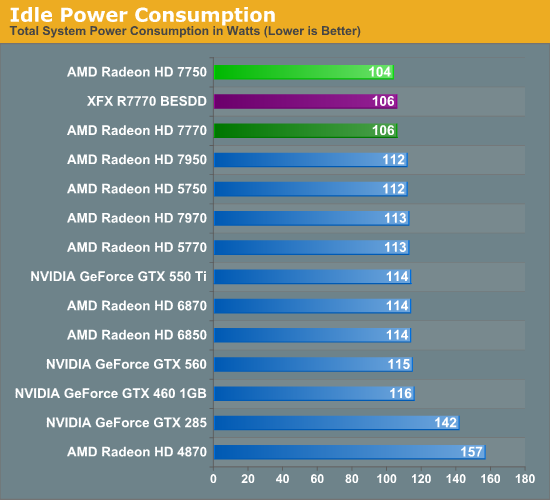
AMD’s official idle power consumption figure is <10W for both the 7750 and 7750. In practice we find that there’s a 2W difference between the two cards, with the 7750 coming in at 104W at the wall and the 7770 at 106W. AMD’s continuing efforts to reduce idle power consumption are clearly paying off, making this the lowest idle power usage figures we’ve recorded yet.
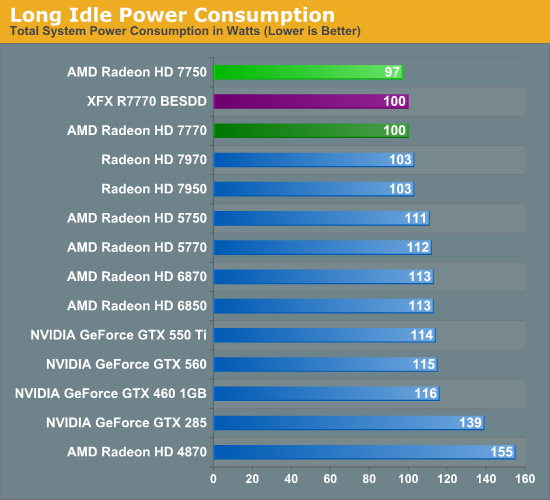
Meanwhile under the so-called “long idle” scenario with a blank monitor, the 7000 series continues to cement its lead. Officially all Southern Islands cards have a long idle power consumption level of <3W since they should all be using the same PCIe controller to keep a heartbeat going, however we’re finding there is a difference, even between the 7750 and 7770. The 7770 consumes 3W less than the 7900 series, meanwhile the 7750W consumes another 3W less, bringing it down to 97W. Since our readings are from the wall it’s tough to gage just how much these cards are still using, but at this point there doesn’t seem to be much farther to drop.
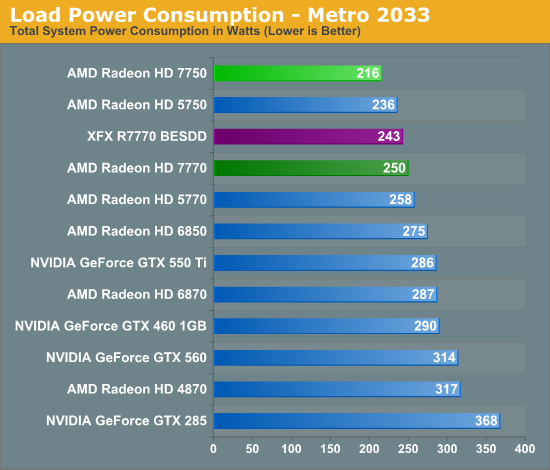
When we talk about the 7700 series bluring the line between what we’d expect out of an AMD 700 series card and an AMD 600 series card, results like this are part of the reason why. With a 75W PowerTune limit the 7750 has the lowest power consumption of any of the cards in our lineup, beating even the 5750. The 7750 is clearly in a league of its own, with only the 7770 drawing similar amounts of power as the 5700 series.
To that extent, it’s interesting to note that the XFX BESDD consumes less power than the reference 7770, in spite of its factory overclock. XFX did not increase the voltage of the card, but we’d still expect power consumption to go up at least a bit, not come down. In any case even with its 10% better performance, it’s consuming 7W less than the reference 7770 here. Otherwise at 250W the 7770 is pulling 8W less than the 5770 and 25W less than the 6850 from the wall, succinctly showcasing the power benefits of TSMC’s 28nm process.
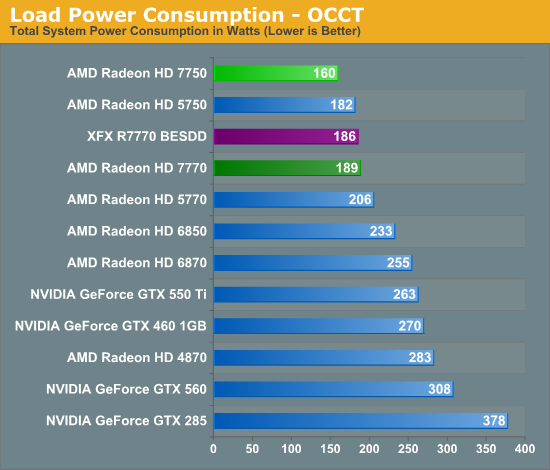
Our results with OCCT largely mirror Metro, with the 7750 in a class of its own while the 7770 consumes less power than anything other than the 5750. Since this is our pathological test, the lack of PowerTune plays a big part here, as PowerTune keeps the 7770 capped at 100W while the 5770 and 6850 are free to go well over their TDPs.
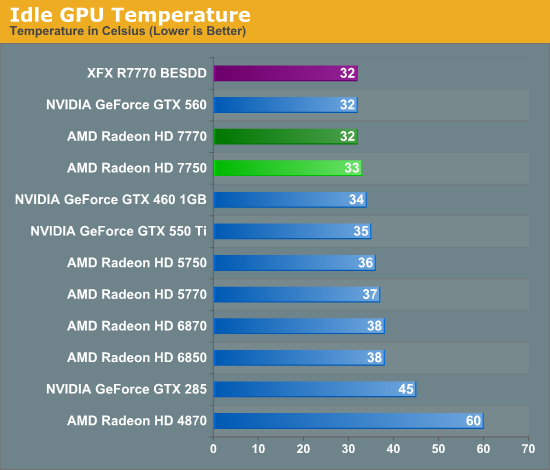
There’s little to say about idle temperatures that hasn’t been said before. With a half-decent cooler, almost any card can reach the mid-to-low 30s. The 7700 series is no exception.
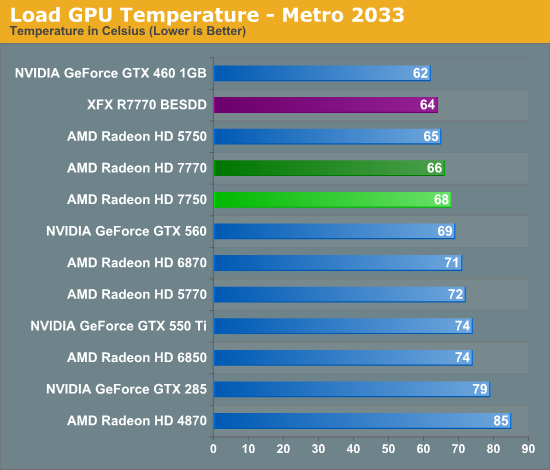
Moving on to Metro, our results are largely consistent with what we’d expect given our earlier power data. Even with the lower power consumption of the 7700 series AMD can’t quite beat the GTX 460 1GB, otherwise with temperatures in the mid to upper 60s the 7700 series looks quite good. XFX’s BESDD looks especially good thanks to the fact that it’s an open air cooler, as it only reaches 64C.

As with OCCT power consumption, OCCT temperatures are largely a story of PowerTune or the lack thereof. With PowerTune clamping down on power consumption, temperatures never rise by too much. At 71C the reference 7770 is still doing well, while XFX’s card does even better.
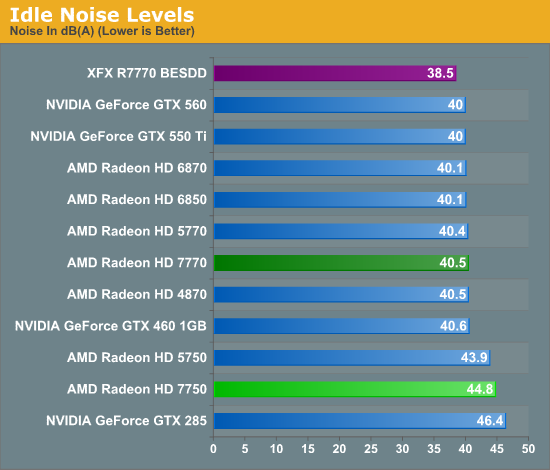
Based on our power and temperature data, our noise data came at somewhat of a disappointment. The 7750 has a small fan with an idle fanspeed of 39%, leading to it being quite loud relative to its competitors. Thankfully none of AMD’s partners will be using that specific cooler, so we wouldn’t expect any retail cards to be this bad. Though if silence is key, Sapphire’s passively cooled 7750 is always an option.
As for our 7770 cards there aren’t any surprises. The open air cooled XFX BESDD does the best, though at only 40.5dB the reference 7770 is doing almost as well on its own.
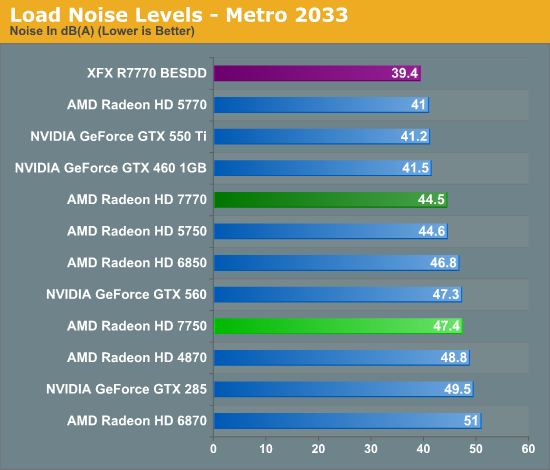
I had to rerun Metro a few times just to make sure our XFX BESDD numbers are right; and they were. XFX’s open air cooler combined with the 100W board limit of the 7770 means that there’s relatively little heat to dissipate, which the open air cooler does extremely well. While this isn’t technically silent it’s damn close.
Elsewhere the reference 7770 does decently, but its half blower nature hurts it when it comes to noise. The noisy 7750 only gets louder, unfortunately.
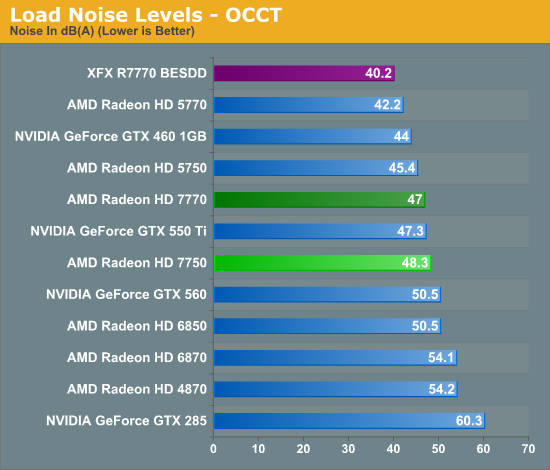
Finally, noise under OCCT is nearly the same story. The XFX BESDD finally goes above 40dB, a testament to the capabilities of XFX’s open air cooler. As for the AMD cards, there’s really not a great deal positive to say as even a traditional blower shouldn’t be quite as bad as what we’re seeing with the reference 7770. Perhaps it’s for the best that none of AMD’s partners are using their reference designs.










155 Comments
View All Comments
Dug - Wednesday, February 15, 2012 - link
For the cost of one game you could just get the nvidia 560. In fact you could of gotten it a long time ago and still be way ahead.beginner99 - Wednesday, February 15, 2012 - link
Well seeing this makes me feel a little less bad on how much a paid for my 5850 1.75 years ago. Absolutely 0 reason to upgrade...However now it seems AMD GPU division is starting to blunder too...
solarTermination - Wednesday, February 15, 2012 - link
I really don't understand what AMD is thinking here. The 7770 is preposterous at this performance/price level, and it boggles the mind that they designed it this way. I'm really stumped here, it's like they're spitting in all of our faces to release a card that has less performance and costs more than a widely available 2 year old part.They must take us for fools. Nothing else could explain this. Technology is supposed to improve as the years go by, not tread water, and certainly not get worse. You see this kind of bs and the revolving door of talent at AMD starts to make more sense. There must be some real pieces of work running that place.
I think it's finally time to join them. Nvidia, here i come.
CeriseCogburn - Saturday, March 10, 2012 - link
It's obvious isn't it ? They are a collapsing wreck that have culled with the ax their dwindling workforce as they've sold off assets to leave them with nothing but ip.Now after striking away Bain Capital style at the failing red bottom line - in the deep debt for endless years under the tightwad whining fan base and OCD focused complaint review sites meshing pennies and fps to an insane nuovo art form that should embarrass it's fans rather than fill them with false self esteem and self congratulating "I'm brilliant" mirror apprasials, they must further the save their life goal and actually ask their tenderly coddled and deceived rabid fan base to cough up some survival dollars...
Unfortunately, the years of low price bragging filled with lies albeit effectiveness as an ignorant fool lives in bliss, has come to backfire on them at the worst time possible, the end of the line.
As Mr. Smith said, it was inevitable.
Now amd needs a hero to save it's collapse and absorption into the wider market matrix.
shin0bi272 - Wednesday, February 15, 2012 - link
I have a gts250 and I get about the same fps as the 7750. I paid just over 100 bucks (109 IIRC) for it and its almost 3 years old and keeps up with these brand new cards. I cant decide if that's funny or sad.Menoetios - Wednesday, February 15, 2012 - link
While these cards definitely deserve flak for their starting prices, I'm not nearly as disappointed overall as many here seem to be. I have no doubt that their prices will come down in time. Consider that the 7750 is the absolute slowest GCN card. I fully expect to see a tastey sub-$90 price for the 7750s by the time Nvidia gets their 28nm line out. The 28nm process is still extremely supply constrained; it wouldn't make sense to price the cards out any lower to increase sales when there simply aren't any to sell. Whether Kepler trounces GCN or equals it, its introduction will be when the real shift in the price/performance shift occurs, both from competitive pricing as well as the 28nm ramp up.kmmatney - Wednesday, February 15, 2012 - link
Well, I'm glad I was able to pickup an HD6850 for $139 shipped (no rebates). I can see why the 7750 would be great for notebooks, but I don't see much point in this card for the desktop.CknSalad - Wednesday, February 15, 2012 - link
I think it's safe to say that ever since the release of bulldozer, AMD has been hit hard financially. They spent a lot of R&D and probably put all their eggs in one basket in that project. As much as their efforts can be admired, it seems that this has taken so much of AMD R&D money that now they don't have much to offer for even their gpu lineup.I understand that there is little competition and that this is the 'first gen' of 28nm cards, but there should seriously be at least 10-15% performance boost for the whole lineup. Going from 40nm to a 28nm process is a big jump. The 'there is little competition' so these cards are priced this way is still unacceptable. I'm starting to be wary of the 7800 series cards as I'm looking forward to buying a card no more than the low $300 range.
Hopefully Nvidia has something up their sleeves and can give us true 28nm performance we should be seeing. I am in no way an nvidia fanboy as I have had both ati and nvidia cards. The only thing i worry for nvidia's kepler cards is the power consumption. However, if the performance gain more than makes up for the minor increases in power consumption, then it will be more than worth it.
Sttm - Wednesday, February 15, 2012 - link
Yes they are price gouging for the next 3 months because they can. Also the 7700 series is complete shit performance wise and will only find its home in the hands of the uninformed and the low power systems built by Dell and HP.Nvidia is the only hope of seeing a good price/performance boost now.
Sttm - Wednesday, February 15, 2012 - link
"and at that point, this card at 159$ would make sense."No it wouldn't actually, since with the move to 28nm you should be seeing a performance increase per dollar not the same. The performance of a 6850 should be around $79 this generation, with the $160 cards offering almost 6950/560ti level of performance.
This is what Nvidia will most probably be offering with their next gen parts, and what AMD will have to lower their costs to if they expect anyone outside of the fanboys to but them.